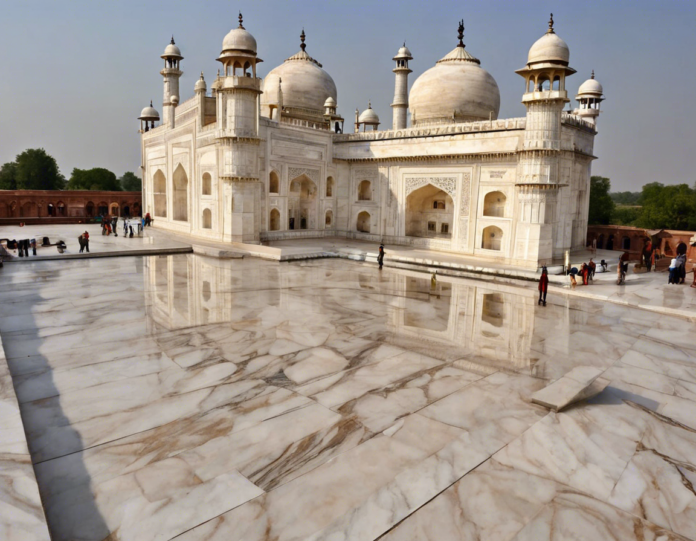Introduction
Agra, a city located in the northern state of Uttar Pradesh, India, is renowned for being home to one of the most iconic symbols of love and architectural wonders in the world – the Taj Mahal. This marble marvel, built by the Mughal Emperor Shah Jahan in memory of his beloved wife Mumtaz Mahal, attracts millions of visitors from around the globe each year. However, Agra has much more to offer beyond the Taj Mahal. In this article, we will delve into the various marble wonders of Agra beyond the Taj Mahal, exploring other magnificent structures and notable attractions that showcase the beauty and grandeur of marble architecture in this historic city.
The Agra Fort: A Marvel in Red Sandstone and Marble
Agra Fort, also known as the Lal Qila, is another UNESCO World Heritage site in Agra that exemplifies Mughal architecture at its finest. The fort, constructed by Emperor Akbar in the mid-16th century, is predominantly built with red sandstone, but it also features marble elements that add a touch of elegance and opulence to its design. The marble structures within the fort, such as the Pearl Mosque (Moti Masjid) and the Khas Mahal, exhibit intricate marble inlay work and exquisite carvings that showcase the skilled craftsmanship of Mughal artisans. The Agra Fort stands as a testament to the rich architectural heritage of the Mughal era and offers visitors a glimpse into the grandeur and power of the Mughal Empire.
Itmad-ud-Daulah’s Tomb: The Jewel Box of Agra
Often referred to as the “Baby Taj”, the Itmad-ud-Daulah’s Tomb is a marble mausoleum that predates the Taj Mahal and serves as a precursor to its grandeur. Commissioned by Nur Jahan, the wife of Mughal Emperor Jahangir, in memory of her father Mirza Ghiyas Beg, this exquisite tomb is adorned with intricate marble inlay work, semi-precious stones, and delicate carvings that reflect the delicate artistry of the Mughal craftsmen. The Itmad-ud-Daulah’s Tomb is set amidst a charbagh-style garden with water channels and reflects a fusion of Persian, Indian, and Islamic architectural styles. Visitors to this marble masterpiece are captivated by its beauty and ornate design, making it a must-visit attraction in Agra.
Marble Handicrafts of Agra: A Testament to Artistic Excellence
Apart from its architectural gems, Agra is also renowned for its exquisite marble handicrafts that showcase the artistic prowess of local craftsmen. The city is famous for its marble inlay work, known as “Pietra Dura”, which involves the intricate art of setting semi-precious stones into marble to create stunning designs and patterns. Agra‘s marble artisans are skilled in crafting a wide range of products, including tabletops, vases, decorative items, and jewelry boxes, using this traditional technique. Visitors to Agra can explore the local markets and shops to admire and purchase these intricately crafted marble artifacts, which serve as unique souvenirs and mementos of their time in the city.
Frequently Asked Questions (FAQs)
Q1: What is the significance of marble in Agra’s architectural heritage?
A1: Marble plays a significant role in Agra‘s architectural heritage as it is used in iconic structures such as the Taj Mahal, Agra Fort, and Itmad-ud-Daulah’s Tomb for its beauty, durability, and symbolic value.
Q2: What is unique about the marble inlay work in Agra?
A2: The marble inlay work in Agra, known as “Pietra Dura”, is a specialized art form that involves setting intricately cut semi-precious stones into marble to create elaborate designs and patterns with precision and skill.
Q3: What are some popular marble handicrafts available in Agra?
A3: Some popular marble handicrafts in Agra include tabletops, vases, decorative items, and jewelry boxes, all crafted with intricate marble inlay work by skilled artisans.
Q4: How can visitors explore the marble marvels of Agra beyond the Taj Mahal?
A4: Visitors can explore iconic marble structures such as Agra Fort and Itmad-ud-Daulah’s Tomb, as well as visit local markets to admire and purchase marble handicrafts as souvenirs.
Q5: What is the best time to visit Agra to explore its architectural marvels?
A5: The best time to visit Agra is during the winter months from October to March when the weather is pleasant and ideal for sightseeing and exploring the city’s marble wonders.
Conclusion
In conclusion, Agra is not just synonymous with the Taj Mahal, but it is also a treasure trove of marble marvels that showcase the city’s rich architectural heritage and artistic excellence. From the Agra Fort to Itmad-ud-Daulah’s Tomb and the exquisite marble handicrafts found in local markets, Agra offers visitors a glimpse into the opulent world of the Mughal Empire and the enduring legacy of marble architecture in this historic city. Whether admiring the intricate marble inlay work of Mughal monuments or acquiring marble artifacts as keepsakes, a visit to Agra is a journey through time and beauty that leaves a lasting impression on all who explore its marble wonders.









